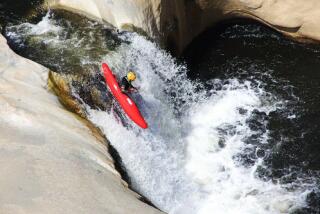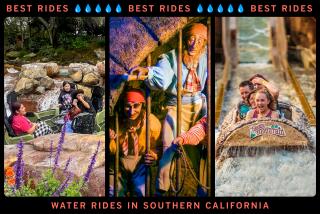Weekend Escape: Stanislaus River : Rapid Transit : A Rafting Trip in Mother Lode Country Lets Kids--and Parents--Taste Adventure
COLUMBIA, Calif. — For several weeks, 12-year-old Sam lamented the lack of adventure in his life. Been there, done that, he said. Beach smeach.
So the challenge: Come up with something for young Indiana Jones that would still be fun for Ben, 9, and Katie, 6.
We decided on white-water rafting on the Stanislaus River, a one-day trip ($65 per youth, $85 per adult) that wends through a beautiful limestone canyon in Mother Lode country about 40 miles west of Yosemite.
Rivers are rated in classifications that run roughly from one (bathtub splashing) to six (bring your own barrel to Niagara). Stanislaus is rated class 3 or moderately difficult, with enough white water to thrill the kids but not enough to give us ulcers. We hoped.
After a six-hour drive from Los Angeles, we arrived in Columbia--a small historic mining town--and settled into the Columbia Inn Motel, a half-mile from where we would meet the following morning for rafting. For $76 a night, we got a noisily air-conditioned suite that included two bedrooms and a bathroom.
The next morning, dressed in bathing suits, shorts and old sneakers, we drove to meet our rafting guides. We solemnly slathered on sunscreen and trooped aboard the blue school bus that would take us to our river.
We had agonized over bringing Katie. Though an able swimmer, was she too young? Most outfitters take children ages 7 or 8 and up. After we selected Columbia-based Zephyr Whitewater Expeditions, the guides assured us that she could travel in the more-stable lunch raft, an oar boat loaded with food.
Aboard the bus, our driver warned our group about sunscreen. “Don’t put lotion on your foreheads--it will just drip into your eyes. And don’t put it on the backs of your legs--it’ll make it harder to grip,” he called out. Too late. “Oh great, now we’re in for it,” mumbled Sam, envisioning vain attempts to clutch a raft with his greased legs as it bucked beneath him.
After a 50-minute ride bouncing along an old one-lane road--a Class 5 bus trip to a Class 3 river, the guides joked--we reached our cobalt-blue rafts and were snugly fitted into our life vests.
Our guide and trip leader Ralph Posten explained the various mishaps that might befall us. The rafts could flip. Or get punctured and deflate. We might be knocked overboard. Should we find ourselves underwater beneath the boat, it was best to push down from the boat bottom and swim out from under it. The main thing, Posten assured us, was to stay calm, and always float feet-first. And stay away from trees and logs that might trap you in a current.
“I want to go in the lunch boat with Katie,” announced Ben, whose only notion of a white-water raft trip was from a Cinemax film about the Colorado River--terrifying footage that showed passengers being flung like dolls from their vessels and rafts overturning into angry, churning water. An afternoon playing Game Boy on the living room couch was looking better and better.
We reassured him that the river we were about to face was nothing like the Colorado. Then Posten explained that he’d been a guide for 16 years and had suffered no misfortune.
*
Katie settled happily into the oar boat, waving and grinning where she sat between two older women, who also wanted a more sedate voyage. The four of us joined two Canadian women in a paddle raft and Posten, seated at the rear, put his rookie crew through basic training. Right turns. Left turns. Back paddling. And double-time or “digging in.” Of course, the most important tactic Posten showed us was how to use our paddles to splash the six other boats in our group.
With that, we paddled into the river’s current, where every rapid had a name and a story. There was Cop Rock, a tribute to the five policemen it stranded some years ago. And Big Dog, where a woman’s shorts got snagged on a tree, trapping the woman in a compromising position during the extended rescue.
But after the first few rapids, which were among the most difficult on the river, we realized we were going to get bounced, drenched and have a blast. Katie described one of the rapids later: “You go down, then you go up. Then you go down and then you go up and then you get a big splash. It was kind of scary and kind of fun.”
Ben quickly relaxed and launched fierce water fights with the others in our flotilla. Under the hot sun, the cool clean water was wonderfully refreshing. And Posten kept our group entertained by pointing out the various hide-out caves used by the legendary bandit Joaquin Murieta.
Mid-morning, Posten suggested we float through some light rapids. We all jumped overboard, Katie too, floating on our backs as the current pulled us along.
Shortly after noon, we found a lovely sandy area and pulled off for lunch. The guides set up a table with a huge spread of sandwich-makings, fruit and juice.
The Stanislaus was the site of one of California’s most prolonged environmental battles, and you can see, well up the canyon sides, where vegetation was killed when the New Melones Reservoir was filled about 12 years ago. Many years’ drought has brought down the water level and reopened the river for rafting. (We were told it would take several years of strong rainfall to refill the Melones, so rafting is safe for the near future.)
It remains a spectacular canyon. There are no roads in sight, only occasional signs of old mining ruins. Eagles fly overhead, and blue heron nest on the banks, once the territory of the Mi-Wok Indians. A number of outfitters run the river into October.
After lunch, we piloted our rafts through a quieter series of rapids. But not to worry about adventure: Posten corralled the rafts alongside some cliffs leaning out over a wide pool. Yup, time for a high dive. As Posten put it, the place he had chosen was about 25 feet above the water. But in the retelling, it would become 70 feet. For those of us afraid of heights, of course, it seemed like 70 feet. After Sam and Ben saw their knock-kneed Dad go for it, they took the feet-first plunge.
There was nothing left to fear.
The rafting ended about 4 p.m. with a tow through about a mile of the reservoir where the river stops flowing.
*
Ecstatic after the raft trip, we spilled into the streets of Columbia. With no cars allowed in the historic part of town, Columbia is vintage Western, replete with a dusty main street, hitching posts, a blacksmith and saloons. After scouting out the museums, we made a beeline for the authentic stagecoach parked outside the Wells, Fargo & Co. building on Main Street, buying tickets ($4.50 per child, $5 per adult) to ride shotgun on top of the coach. Katie giggled and beamed, especially when we got held up by a masked rider.
From there, we zipped over to the gold mining outfit where young prospectors can rent pans ($3) to sift through a mud-filled trough. In one hour, each had enough gold (or fool’s gold) to be content.
For dinner, we selected the Lickskillet Cafe on State Street, which offered reasonably priced California cuisine, outdoor tables and room to run, an important attribute for the young and the restless.
The next morning, we discovered a marvelous trail near town leading, after a half-hour hike, to a place called Natural Bridges. There, a small stream trickled into a series of huge cathedral-like limestone caves. We swam through deep, dark pools of fresh water and came out the other side.
Before we left, we stopped at Springfield Trout Farm just outside Columbia, where the proprietors supply tackle and you pay for the fish you catch. Once the kids snared some frisky trout, which were cleaned and packed on ice, we headed out of town.
Sam judged the rafting trip a success and wrote this afterward: “It made Raging Waters and Wild Rivers times 20 look sick. You paddle left, right, forward, backward and hang on for dear life. If that’s not enough, you jump off 25-foot cliffs, have gruesome water fights, see great views, float in pools and get splashed to death.”
Budget for Five
Gas from Los Angeles: $38.00
Lodging, two nights: $164.16
Breakfasts, two days: $46.00
Fast-food lunches, two days: $31.78
Dinners, two nights: $100.81
Rafting with $10 tip: $375.00
Stagecoach fares: $23.50
Gold pan rentals: $9.00
Trout: $16.00
FINAL TAB: $804.25
Zephyr River Expeditions, P.O. Box 510, Columbia, Calif. 95310; (209) 532-6249
More to Read
Sign up for The Wild
We’ll help you find the best places to hike, bike and run, as well as the perfect silent spots for meditation and yoga.
You may occasionally receive promotional content from the Los Angeles Times.






